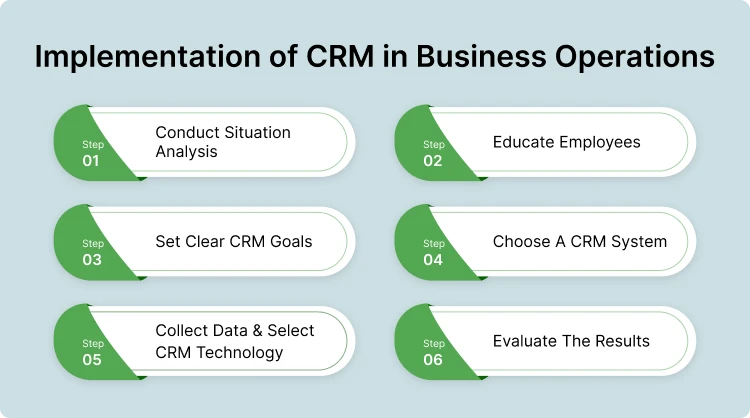 Customer Service
Customer Service

12 May, 2024

As new trends and technologies emerge, your customers’ needs are constantly changing. Thus, it is crucial to incorporate customer relationship management(CRM) strategies into your business activities to meet your customers’ needs.
So, what is the ultimate aim of customer relationship management? CRM involves collecting and analyzing customer purchasing data to understand their needs and develop products that meet those needs. The aim of CRM is to build and maintain a strong customer base.
In this article, we will talk about the main goals, purpose, and components of the CRM strategy. So, let’s get started!
Contents
The concept of customer relationship management first emerged in the early 1990s. Back then, it helped companies integrate automatic marketing and sales services into their operations. However, today, CRM has evolved into a broader concept.
Customer Relationship Management is the study of customers’ perceptions of an organization or brand and providing better customer service by analyzing data obtained through customer interactions.
Amazon is a great example of how companies can use CRM strategies to gain an advantage over their competitors. Amazon has created its own CRM software that tracks customers‘ purchase history. Then, this software customizes the website based on their buying behavior.
For instance, if you often purchase house cleaning products, Amazon’s CRM software will notice this and recommend similar items when you visit the website.
Below we have listed the reasons why you should use customer relationship management strategies:
The main objectives of customer relationship management are to:
Below, we have listed a few customer relationship goals:
Generally, CRM benefits your organization in the following ways:
According to researchers, if you can effectively implement customer relationship management practices in your company, it can increase your company’s performance by 30%.
It is tough to attract new and younger customers to purchase your products. This is because 67% of these customers are sensitive to prices and product quality.
So, you should retain your current customers by providing:
When Apple first launched iPods, they quickly gained 70% of the market share of MP3 players. This, in turn, increased the popularity and profitability of the company.
Thus, by implementing CRM practices, you can align your new product’s features with the present needs of the consumers. As a result, customers will readily accept your new product, and you can expand your business.
To attract new customers and effectively manage and improve your business’s conditions, you should implement CRM strategies. Some of these strategies include:
Read the information we have given below to learn about the features or elements of the client relationship system.

According to researchers, having skilled employees and a positive work environment helps in developing long-lasting relationships between businesses and their clients. You can do so by ensuring the following things:
Another component of the CRM process involves using technology to gather, analyze, and share customer data within your company. As per researchers, you should invest 10% of your business resources into the technological part of the CRM process.
For instance, you can set up multiple communication channels like direct mail, call centers, or a Facebook page to interact with customers. Plus, you should properly implement data warehousing in your CRM software to store, analyze, and distribute customer data.
You must ensure all your business processes focus on creating value and satisfaction for your target customers. According to researchers, your organization should have a management process that focuses on:
Researchers have discovered companies that adopted CRM strategies noticed a significant reduction in expenses, an increase in revenue generation, and gained a loyal customer base.
Read on to discover more reasons why integrating a CRM system into your organization is important.

If your company is web-based or if you generate most of your revenue from online orders, there is a chance that 65% of first-time purchasers won’t buy from you again. Thus, CRM helps you focus your marketing activities on customers who repeatedly purchase your goods.
CRM allows you to segment your customers based on their buying behavior and customize your marketing strategies to attract each segment.
It will help you respond to inquiries from your target customers more quickly. For example, when the city council of Lynchburg used the CRM system, they noticed that it reduced their response time to customers by 50%.
The CRM system includes a set of data management tools. You can use them to organize your customer data in one place. This can help you get rid of inaccurate data, reduce data management costs, and improve your sales strategies.
Researchers consider CRM as a Green IT tool. So, by implementing the CRM system within your organization, you can save resources and increase its environmental sustainability.
Getting new customers to purchase your products is more costly than retaining old ones. Thus, you should use the CRM system to build long-term relationships with your clients and retain them.
When Islamic Bank integrated a CRM system into its operations, customers received instant services from the bank. This resulted in higher customer satisfaction and loyalty. So, it can help you ensure customer satisfaction and build customer loyalty towards your brand.
There are some important steps you can take to incorporate Customer Relationship Management strategies into your business. Check out the steps we have explained here to learn how companies like Nike and H&M implement CRM into their daily operations.

Experts within the company should conduct a situation analysis. Then, they must decide on:
Afterward, the higher officials should educate the management team and other employees in the company about the various aspects of CRM. This will help clear up any misunderstandings about CRM among the company’s staff.
Next, stakeholders within the company should establish clear goals for adopting the CRM strategy. Look at the picture we have provided below.

Here, you can see the top goals organizations have for adopting CRM:
The experts within the company need to select a CRM system that can specifically meet their requirements and fit their budget.
In this step, the marketing team needs to collect accurate data and select the appropriate technology to implement CRM strategy in their daily business operations.
At the final stage, company officials must evaluate the results of implementing CRM in their business activities. Based on these outcomes, they can identify any gaps in their project.
Read the information we have given below to learn more about the aim of customer relationship management.
Customer relationship management solution is basically a set of advanced software that helps a company to interact with their target customers, gather their data, and generate future sales based on that data.
The objectives of client relationship management is to improve a company’s customer service relationships, retain existing customers, and drive sales.
You can measure customer retention rates, average sales, and customer lifetime value to analyze if CRM strategies are giving the results you expected.
Overall, Customer Relationship Management is a marketing phenomenon that aims to make your company more customer-centric and develop stable relationships with your customers. This ensures that your customers receive maximum utility from your offered products and services.
Experts have found that satisfied customers result in greater acceptance of your company’s products, attract new customers, increase sales, and provide your company with a competitive advantage. Thus, you should consider implementing CRM strategies within your organization.